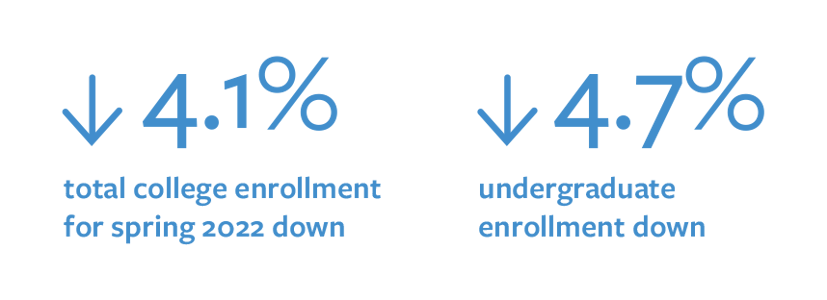WHITE PAPER
Why Smart Scheduling Matters
You’ve done your best when it comes to predicting how many students will enroll in the upcoming semester, but can you adjust to real-time enrollment fluctuations? Consistent collaboration between academic affairs and enrollment management is an essential component of Smart Scheduling™.
Why Smart Scheduling Matters
Smart scheduling is a hot button topic for students and institutions alike. According to a recent report from National Student Clearinghouse, total college enrollment for spring 2022 fell by 4.1 percent, with undergraduate enrollment falling by 4.7 percent. And with an increased number of potential students questioning the value of a degree, now is the time to determine if your institution is making the most of its enrollment process.
 Enrollment and class scheduling are critical sources of information for current and prospective students. Knowing the class schedule in advance allows students the ability to organize their school schedule around home life, childcare and work. Many students want to be full-time but often can’t make a full-time schedule work. Too often, colleges rely primarily on "roll forward" scheduling instead of taking a student-centered approach. The result? Scheduling conflicts and lack of availability that shift a full-time student to part-time status, lengthening overall time to completion.
Enrollment and class scheduling are critical sources of information for current and prospective students. Knowing the class schedule in advance allows students the ability to organize their school schedule around home life, childcare and work. Many students want to be full-time but often can’t make a full-time schedule work. Too often, colleges rely primarily on "roll forward" scheduling instead of taking a student-centered approach. The result? Scheduling conflicts and lack of availability that shift a full-time student to part-time status, lengthening overall time to completion.
5 Steps to Smart Scheduling™
Recognize scheduling and class schedules are a primary source of anxiety for students
![]()
Boost communication and collaboration between academic affairs and enrollment management
![]()
Use data to inform decisions on late or changing schedules
and to free up space, funding and/or teaching capacity constraints
![]()
Train decision makers on understanding and using enrollment data optimally
Survey current students regularly on scheduling wants and needs
Interested in taking your scheduling practices to the next level? Click here to see how Ad Astra is helping more than 500 colleges and universities with Monitor & Predict.
Collaborate and Communicate
Building a better scheduling strategy begins with a team approach. This Completion Coalition should include members of the Registrar’s office and advisors who work directly with students along with decision makers: deans and department chairs and those in Provost’s office. These team members must also have an ability to understand and access timely enrollment data. Many institutions leverage reporting and tracking solutions that work in tandem with their Student Information Systems (SISs.)
Without this it becomes easy to fall back on the status quo, a decision that could impact retention of current students and deplete the pool of prospective students. Institutions that do not make this a priority could suffer a downturn in institutional revenue as students shift from full-time to part-time status or leave the institution in frustration.
Collaboration between enrollment management and academic affairs, paired with the application of timely data, can help institutions maximize the use of resources while ensuring students achieve degree velocity, a key measurement for students and institutions alike.
Authors
Jim Black
President and CEO of SEM (Strategic Enrollment Management) Works
Laura Kelley
VP of Solution Strategy, Ad Astra
Ready to learn more about how Ad Astra can help
you streamline processes and achieve a student-centered schedule?
you streamline processes and achieve a student-centered schedule?







